Part Two: Myth and Legend
The tense relationship between human and animal has been evident throughout all of documented history in the form of storytelling, visual art, and particularly in legend and myth. Since humans and animals have consistently lived side-by-side in all environments, from urban to rural, arctic to rainforest, and done so in both harmonious and contentious circumstances, the tenuous balance of human and animal relationships has been a perpetual source of narrative inspiration. Animal myths help people make sense of these tensions in human-animal dynamics; unlike animal allegories in which the animal characters are used to represent humans – see George Orwell’s (1903-1950) Animal Farm (1945) as the prime example – animal myths most often demonstrates a specific quality or manner of the animal subject.

Many animal myths illustrate the helpful nature of animals towards humans. Through magical folktale motifs like the animal guide, the animal bridegroom, or animal transformation, the role of an animal as a mental and emotional benefactor is demonstrated symbolically as the animal and human boundaries are blurred. Many of the Western European folktales collected by the Grimm brothers featured animals transforming into humans after marriage to a human. Other versions of the animal bridegroom motifs include the Scottish legend of the Selkies - creatures resembling seals who transform into humans and marry people before they return to the sea, and several Indigenous North American religious and folklore stories that feature people marrying bears and deer. Other mythologies describe a spiritual link between humans and animals. Though the term Spirit Animal has been co-opted in recent years to indicate any animal with which a person feels a connection, the notion comes from the certain Indigenous people of Central and North America who practice the ancient ritual of discovering the animal with whom a person is spiritually linked. This long history of interdependence and companionship that humans feel toward animals tends to make the threat of an attack by captive or domestic animals all the more unsettling.
The Mares of Diomedes
The Greek myth of Diomedes, King of Thrace, not to be confused with Diomedes the Warrior, chronicles the life of the King and his semi-domesticated wild horses living together on an island in the Black Sea. The story reads like a cautionary tale, warning of the consequences of trying to domesticate wild animals, or of mistreating animals under human watch. The legend has several versions, but all describe the horses as having succumbed to madness due to their diet of human flesh fed to them by Diomedes, who trained them to attack and devour uninvited guests arriving on the island. The horses were said to be shackled in iron and tethered by chains to a manger so that they could not run free as they wished. When Heracles traveled to the island to steal the legendary horses, he freed them from their bonds, and they attacked and ate Diomedes himself. While some versions of the story have Diomedes eaten before the horses are released, the common theme involves the frenetic horses finding freedom and satiation after eating their tyrannical captor.
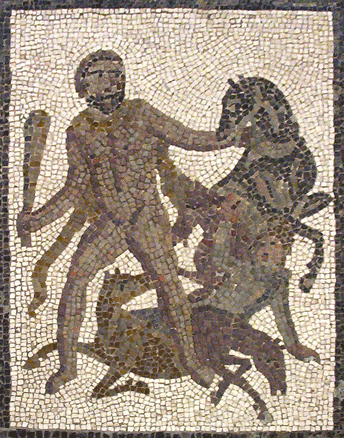
The violence and moralistic qualities of the story were fascinating to Romantic painter Gustave Moreau (1826-1898), who painted several versions of the story’s culminating event. Moreau’s first version is a Gothic rendition featuring dark washes of browns and greys over an imposing stone structure that divides the active bottom half of the painting from the static top half, which features a calm and watchful Heracles watching from the shadows. Symbolic of his fall from grace, Diomedes’ crown lies on the ground; he glances towards it and not at the horses as they buck around him, the foremost horse biting and drawing blood from his wrist.
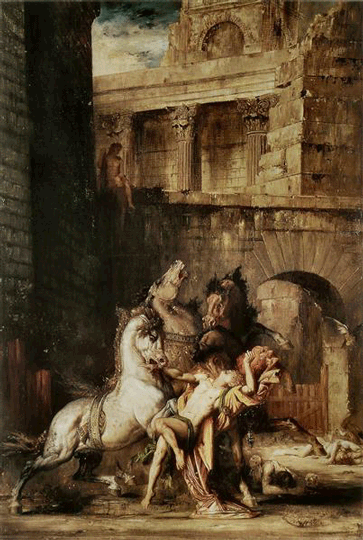
Moreau’s second version is a watercolour painted in 1866 in the classic jewel tones indicative of mid 19th-century French painting. While the scene in this painting is arguably more violent, with two of the horses already beginning to eat Diomedes, Moreau’s unnatural depiction of the central body’s angles distract from the brutality of the scene.
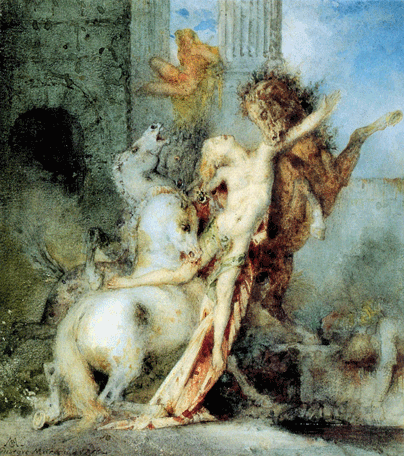
The final version, painted in 1870, is the most Gothic iteration, reverting back to oil paints and amplifying the dark and muddy washes of colour in the middle ground. The central red cloak indicative of flesh and gore contrasts the grimy white and cavernous black of the flanking horses, both biting Diomedes’ limbs and spilling blood. This version, unlike the first with its more sharply rendered peripheral setting, veers towards impressionistically abstracted brushstrokes reminiscent of J. M. W. Turner (1775-1851). The energy and imprecision of the area surrounding the active scene add to the drama and terror being conveyed in the scene.
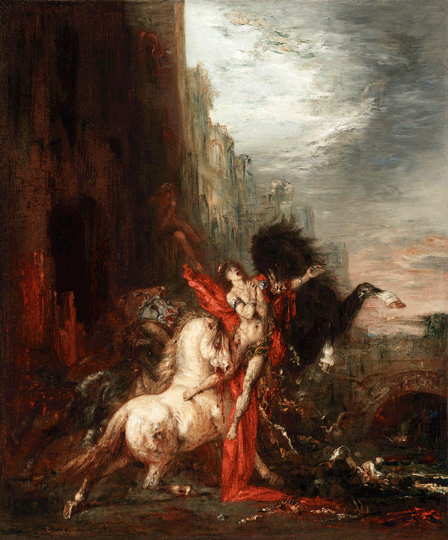
Human-Eating Lions
The lion, the apex predator whose diet consists only of meat and whose name is synonymous with royalty, is the most legendary and fearsome of all animals. While most lions are only interested in hunting their natural prey, the myth of the malicious human-eating lion is a cross-culturally pervasive trope, bred from a select few real-life instances and caste with a veil of the supernatural. The most commonly used animal in historic literature, the lion has come to be known as the most majestic of all creatures, making for a more compelling story of human versus beast if and when things go wrong. Though not particularly common, a lion will hunt and kill humans if the need arises.
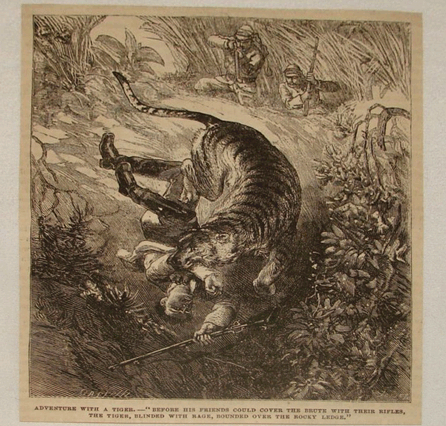
This issue of the human-hunting big cat, however, is more often seen in the tiger population of India, and many paintings throughout history have favoured the tiger for animal attack paintings.
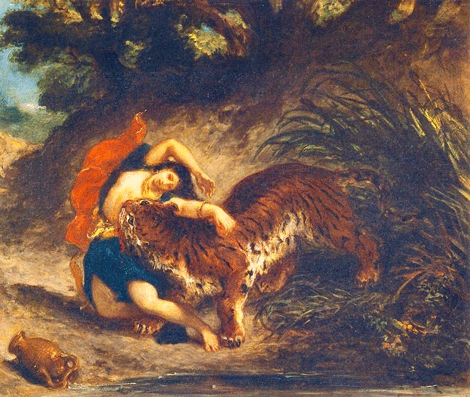
Eugene Delacroix (1798-1863) painted many images of tigers, a popular subject for Europeans who were captivated and horrified by the news of colonizers being attacked by tigers in the East. Incidentally, tiger attacks in India have risen to record numbers as of 2020, as human development continuously expands into tiger habitats. Tigers have continuously posed a greater threat to humans, yet the prospect of the attacking lion is so deeply ingrained in myth and legend, that the image remains at the forefront of people’s minds, and is reflected in art.
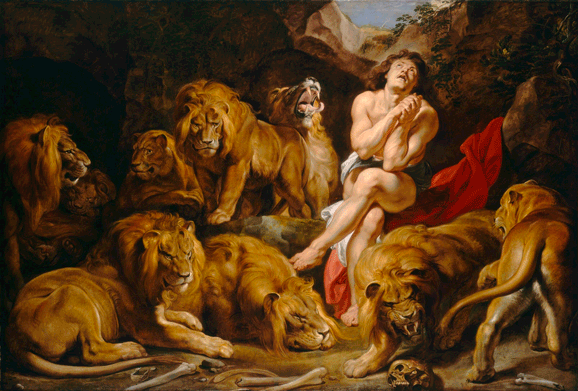
The most famous image in fine art of human-eating lions is that of Peter Paul Rubens’ (1577-1640) Daniel in the Lions’ Den (1615) illustrating the biblical story of Daniel being condemned to spend a night in the lions’ den for declaring his faith in God rather than in King Darius I. As the story goes, Daniel was miraculously saved by God who protected him throughout the night. The success of the painting lies in the expressions on the faces of both human and lions; Rubens’ evokes the desperation and terror in the face of Daniel, as well as the frustration of the lions, who are portrayed as barely restraining their urge to attack the man in their presence.
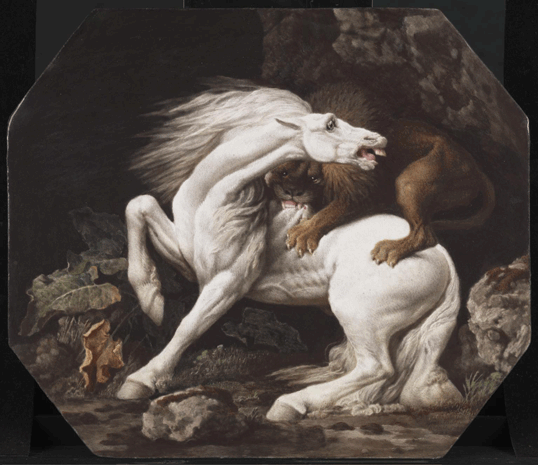
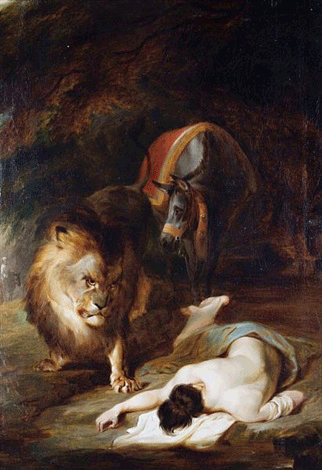
Diverting from myth to reality, the adrenaline-fueled Horse Attacked by Lion (1769) by George Stubbs (1724-1806) showcases the threat to human livelihood when lions attack and kill livestock, an issue still applicable to many areas where human populations exist near lion territory. This type of conflict is often the source of discord between people and lions, and the cause of many human deaths. Prolific animal painter William Huggins (1824-1910) produced dozens of studies of both livestock and predatory animals, specifically tigers and lions. His most dramatic work is the only painting in which humans and carnivorous animals meet; The Lion’s Attack (date unknown) implies a violent interaction as a man lies still on the ground next to a timid-looking horse and a glaring male lion lording over him. Mid-century artist Tom Beecham (1926-2000) painted in similar yet slightly comical fashion. His painting, Lion Attack, features a man being mauled by several lions while touring through the African plains, illustrating the still-relevant fear of animal retaliation for human’s encroachment in their space.
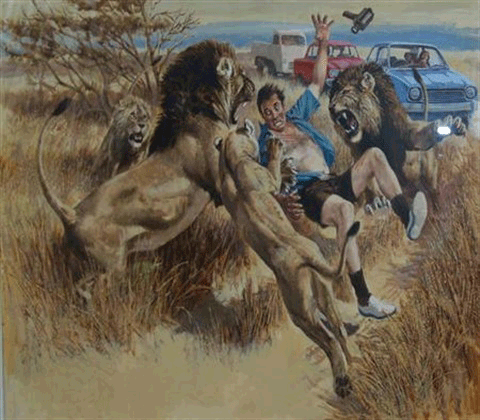
Perhaps the most notorious adaptation of a documented lion attack into popular culture is the story of the Tsavo River massacre of 1898, when for nearly a year two maneless male lions terrorized the crew of a railroad construction over the Tsavo River in Kenya, killing an estimated 135 people and often eating the bodies. The events were canonized in contemporary folklore, and the lions’ motivations have been speculated to be either demonic possession or the angry spiritual retribution against colonizers. More practical theories involve the absence of natural prey in the area due to a cattle plague outbreak, or the possibility of a damaged tooth in one of the lions, causing the pair to look for easy game. Regardless of the motivation, the legend remains captivating to this day. After Lt. Col. John Henry Patterson (1867-1947) shot and killed the lions, their bodies were sold to the Field Museum in Chicago, where they can still be seen by the public, drawing a resurgence of visitors after the film dramatization of the story, The Ghost and the Darkness (1996), was released. The events of the Tsavo River railroad construction continue to inspire many artists, including John Banovich, who painted the menacing portrait of the two lions, Man Eaters of Tsavo, in 2002.
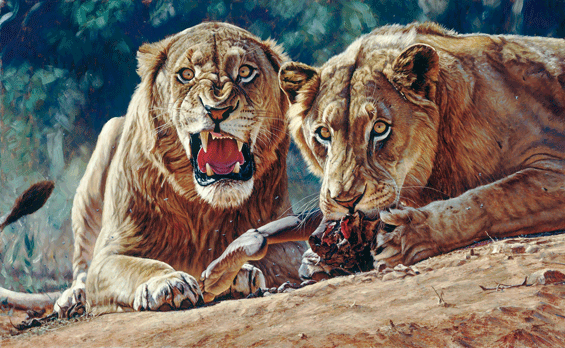
There will always be a sense of dubiousness surrounding human safety and comfort around animals, whether it be the relationship with beasts of burden used to help in day-to-day life, or the effects of human encroach into natural environments. The very real possibility that the animals who share space with humans could strike out in frustration or in an act of vengeance is a concept so ominous that even the rarest of instances of such are often adapted into myth.
